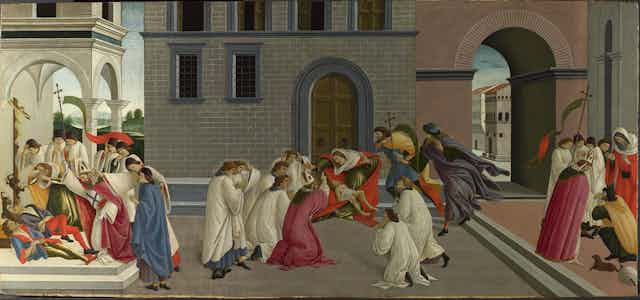A painting is often like theatre. There are actors, who give expression to a narrative. They are distributed across a stage floor and positioned against a scenic backdrop. The artist is both the stage director and the set designer, choreographing the movements and gestures of his leads and extras, as well as choosing their props and painting the background screen.
Such a theatrical approach to painting – something perhaps even inspired by genuine theatre – may have existed in classical antiquity, judging by some of the surviving frescoes from Pompeii. But it certainly came to life during the period that styled itself as the revival of ancient Greek and Roman culture – the Renaissance.
The National Gallery in London has now staged a show that explores an aspect of this role of the painter as a set designer. The exhibition, aptly titled Building the Picture, focuses on paintings from the Italian Renaissance that include forms of architecture in their setting – from porticos and arches to churches and palaces, sometimes entire townscapes.
The exhibition has opened concurrent with the major National Gallery shows on Veronese and German Renaissance painting, both still running. Visitors lured to the museum by these blockbusters will hopefully also reserve some time to walk through this smaller thematic display, accessible for free in the Sunley Room at the centre of the gallery. But I’d recommend that they treat it as a starter rather than a dessert. The scale and scope are such that the exhibition cannot compete for the attention of the viewer with its more grandiose and glamorous cousins.

The curators have selected and arranged a variety of paintings – mostly taken from the National Gallery itself – according to different themes. A small group of drawings illustrate that architectural settings were not a pictorial after-thought. Instead they were an integral element in the planning of paintings. However, from the sketches chosen it is not entirely clear that, as is claimed, a Renaissance artist would design his architectural stage first and then populate it with his actors.
Domenico Veneziano’s Carnesecchi Tabernacle is an example of a type of painting that does not so much include fictitious architecture as was part of a real building. A fresco showing the Virgin and Child, it was detached from a religious shrine mounted on the outside wall of a house in Florence.
In following rooms, we can learn about how painters used architectural elements in their paintings to accentuate figures, and how some scenes are set in meticulously constructed interiors. We can also see how real buildings such as the Doge’s Palace in Venice could pop up in paintings with a propagandistic purpose, and how artists imagined certain iconic pieces of architecture from the past, notably Solomon’s Temple at Jerusalem. And how architectural set design could be used to frame different episodes from the same story, put together in one and the same picture.

One of the stars of the show is undoubtedly Carlo Crivelli’s intriguing Annunciation with St Emidius of 1486. In Crivelli’s composition, the Virgin is kneeling by herself in the interior of a town house, into which we are granted a peek through an open door. The Archangel Gabriel, who has come to announce the birth of Christ, is in the street outside the Virgin’s dwelling, accompanied by St Emidius, the patron saint of the town of Ascoli, for which the work was painted. Gabriel, normally shown in the same space as the Virgin, passes his sacred message not face to face, but through a grated window. A convenient hole drilled high up in the wall allows for a ray of divine light to fall through and carry the Holy Spirit into the Virgin’s womb.
The exhibition is certainly not a comprehensive treatment of the subject of architecture in Renaissance painting. For example, the importance of mathematical perspective – a discovery that dramatically changed what painters could do with the stage floor and backdrop of their architectural settings during the period – is strangely under-stated.

One can also wonder about some of the more allegorical interpretations of architecture presented here. In Vincenzo Catena’s painting of St Jerome in his Study, is it really more than a subjective reading that the saint’s room is warm and inviting and so represents how St Jerome’s translation of the Bible into Latin made the Christian faith more accessible?
Even so, a passage through the Sunley Room will be worthwhile for any visitor keen to have their eyes opened to an otherwise easily overlooked aspect of the National Gallery’s glorious collection of Renaissance paintings.

